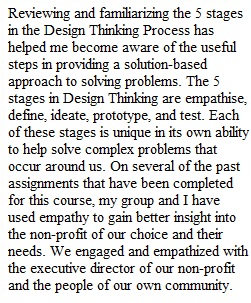


Q Purpose This assignment is intended to help you do the following: • Use a design thinking approach for group problem-solving. • Apply creativity principles and strategies when working in groups. Action Items 1. Review 5 Stages in the Design Thinking Process (Links to an external site.) and become familiar with the five steps of design thinking. 2. Reflect on the assignments you have already done in this series. Did you use Empathy? How could you have used Empathy as you pursued a problem or opportunity? Did you apply design thinking when defining the problem or opportunity? Did you apply design thinking when you were ideating about the problem or opportunity? 3. You are now at the point where you are ideating solution options for your problem/opportunity. Review the section of the article on ideating and consider how you can apply this process to your solutioning. 4. Reflect and write down responses to Action Items 2 and 3 as notes, and then meet with your group members. Create a topic for the group to use. Complete Action Item 5 as a group. 5. Create a 150- to 200-word discussion post as a group that describes how your team considered design thinking as you began solutioning. What were you able to apply from the article? How did thinking about your problem differently help you to come up with richer solutions? Do you think you were more innovative in your solutioning without considering design thinking? Have a spokesperson for the group post the response. 6. Reply to another team’s post. Be sure to follow the Discussion Guidelines when replying to your classmates. All group members should participate in discussion replies. 7. By the due date indicated, complete Action Items 1-5. 8. By Sunday, post at least two replies to your classmates’ postings. Grading Criteria Read the assignment rubric to understand how your work will be assessed.
View Related Questions